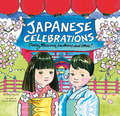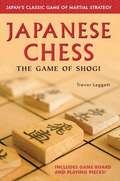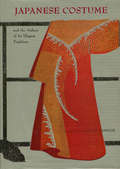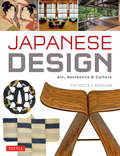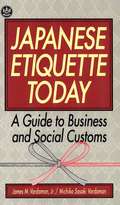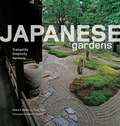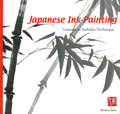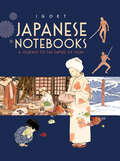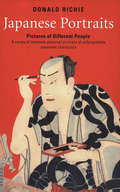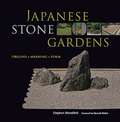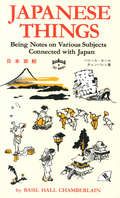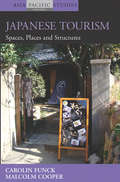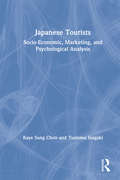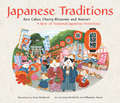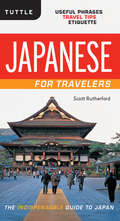- Table View
- List View
Japanese Celebrations
by Betty ReynoldsThe people of Japan love to celebrate! In fact, they love it so much they have a day of celebration, whether it's a change in season, a religious observance, or just a special moment in life, every month of the year. Brimming with ancient traditions, exotic decorations, and delicious, seasonal foods, Japanese Celebrations will take you on a month-by-month tour of some of Japan's best-loved festivals. Beautifully illustrated and full of fascinating facts about Japanese holidays and celebrations, this 48-page picture book offers a vivid picture of some of Japan's most festive events including New Year's, Children's Day, Cherry Blossom Season, Harvest Moon Viewing, Christmas in Japan and many more. With simple but informative text and illustrations that explain the significance of the dress, decoration, food, gifts and activities associated with these events, Japanese Celebrations promises to delight and educate young readers and parents alike.
Japanese Chess
by Alan Baker Trevor LeggettThe ancient game of chess has its roots in India, where the legendary emperor Ravana used it to exercise his generals in strategy and tactics. Played by millions around the world, shogi is the uniquely Japanese variant of chess.Japanese Chess is the ultimate book on shogi for beginners and experienced players alike. Its step-by-step instructions and easy-to-follow diagrams lead the reader through the strategies and intricacies of one of Japan's most popular board games. Shogi is the only variation of chess in which an opponent's captured piece can be dropped back onto the board as one's own. This makes for extremely exciting, dynamic game play in which momentum can quickly shift back and forth between players.This essential resource includes a shogi board bound right into it, folding out for use with the included shogi pieces.
Japanese Costume: And the Makers of Its Elegant Tradition
by Shojiro Nomura Helen Benton MinnichWith dozens of photographs and expertly written text, this Japanese clothing book is the authoritative guide on the kimono.<P><P>Japanese Costume invites the reader to explore the world of Japan's textile arts and costume decoration-from its origins in legendary times, through its brilliant development in the intervening centuries, to its emergence into the modern era. The book which is the first in English to present the full sweep of Japanese achievement in the costume arts, is essential the story of the kimono and its evolution.The text is accompanied by a generous selection of fine illustrations and photographs: 54 in full color, 119 in black and white, and 12 line drawings. They include not only pictures from contemporary sources-such as the picture scrolls and woodblock prints- but also photographs of kimono masterpieces and representative textiles.
Japanese Design
by Patricia J. GrahamWhat exactly is the singular attraction of Japanese design? And why does it speak so clearly to so many people all over the world? The Japanese sensibility often possesses an intuitive, emotional appeal, whether it's a silk kimono, a carefully raked garden path, an architectural marvel, a teapot, or a contemporary work of art. This allure has come to permeate the entire culture of Japan-it is manifest in the most mundane utensil and snack food packaging, as well as in Japanese architecture, and fine art. In Japanese Design, Asian art expert and author Patricia J. Graham explains how this aesthetic based in fine craftsmanship and simplicity developed. Her unusual, full-color presentation reveals the Japanese design aesthetic in an absorbing way, using a combination of insightful explanations and more than 160 stunning photos. Focusing upon ten elements of Japanese design, Graham explores how visual qualities, the cultural parameters and the Japanese religious traditions of Buddhism and Shinto have impacted the appearance of its arts. Japanese Design is a handbook for the millions of us who have felt the special allure of Japanese culture, crafts, and art. Art and design fans and professionals have been clamoring for this-a book that fills the need for an intelligent, culture-rich overview of what Japanese design is and means.
Japanese Design
by Patricia J. GrahamWhat exactly is the singular attraction of Japanese design? And why does it speak so clearly to so many people all over the world? The Japanese sensibility often possesses an intuitive, emotional appeal, whether it's a silk kimono, a carefully raked garden path, an architectural marvel, a teapot, or a contemporary work of art. This allure has come to permeate the entire culture of Japan-it is manifest in the most mundane utensil and snack food packaging, as well as in Japanese architecture, and fine art.In Japanese Design, Asian art expert and author Patricia J. Graham explains how this aesthetic based in fine craftsmanship and simplicity developed. Her unusual, full-color presentation reveals the Japanese design aesthetic in an absorbing way, using a combination of insightful explanations and more than 160 stunning photos. Focusing upon ten elements of Japanese design, Graham explores how visual qualities, the cultural parameters and the Japanese religious traditions of Buddhism and Shinto have impacted the appearance of its arts.Japanese Design is a handbook for the millions of us who have felt the special allure of Japanese culture, crafts, and art. Art and design fans and professionals have been clamoring for this-a book that fills the need for an intelligent, culture-rich overview of what Japanese design is and means.
Japanese Design
by Patricia J. GrahamWhat exactly is the singular attraction of Japanese design? And why does it speak so clearly to so many people all over the world? The Japanese sensibility often possesses an intuitive, emotional appeal, whether it's a silk kimono, a carefully raked garden path, an architectural marvel, a teapot, or a contemporary work of art. This allure has come to permeate the entire culture of Japan-it is manifest in the most mundane utensil and snack food packaging, as well as in Japanese architecture, and fine art.In Japanese Design, Asian art expert and author Patricia J. Graham explains how this aesthetic based in fine craftsmanship and simplicity developed. Her unusual, full-color presentation reveals the Japanese design aesthetic in an absorbing way, using a combination of insightful explanations and more than 160 stunning photos. Focusing upon ten elements of Japanese design, Graham explores how visual qualities, the cultural parameters and the Japanese religious traditions of Buddhism and Shinto have impacted the appearance of its arts.Japanese Design is a handbook for the millions of us who have felt the special allure of Japanese culture, crafts, and art. Art and design fans and professionals have been clamoring for this-a book that fills the need for an intelligent, culture-rich overview of what Japanese design is and means.
Japanese Digital Cultural Promotion: Online Experience of Kyoto (Routledge Contemporary Japan Series)
by Nadejda GadjevaGadjeva uses Kyoto as a case study to explore the innovative mechanisms being used to promote Japanese culture and cultural properties since the outbreak of COVID-19. Beginning by setting out the main initiatives and actors involved in preserving, introducing and utilising Kyoto’s cultural heritage, Gadjeva proceeds to discuss alternative approaches using digital technologies. These tools include remote access immersive reality, virtual reality, augmented reality, augmented virtuality, and mixed reality. She looks at how such approaches have been applied to Kyoto’s digital museums, real-time online experiences, and other virtual projects presenting tangible, intangible, and folk heritage. In doing so she draws on a wide range of interviews with experts from the Japan Foundation, the Kyoto Art Center, and other related institutions to investigate the limitations and possible strategies for further development of these practices. She also interviews scholars, government officials and experts from Europe about the prospects for further remote online experiences, applied both specifically to Kyoto and more broadly to cultural tourism. Based on the findings, the book discusses particular future challenges and suggests specific policies and project proposals for further remote online experiences of Kyoto’s cultural properties. A valuable read for professionals and scholars of cultural and tourism studies, that will be of particular interest to those specialising in Japan.
Japanese Etiquette Today
by Michiko Sasaki Vardaman James M. VardamanJapan today "looks" more and more Western, principles governing social and business relations become harder to see. Most foreigners know that Japanese etiquette differs from that of other countries, but few people know the extent of the differences. It is this diversity that first attracted the authors of Japanese Etiquette Today, a book written to make working and living in Japan enjoyable and rewarding experiences.The authors look at a variety of formal and informal occasions governed by subtle rules-visiting a Japanese office and h ome, giving and returning gifts, attending weddings and funerals, and much more. The result is an informal overview of Japanese society and a manual of practical advice on getting a long in that society. Complete with essential vocabulary and phrases, this handy guidebook explains what to do and perhaps more important what not to do, what to say, what to wear, indeed, whatever you need to observe the complex rules of modern Japanese etiquette.
Japanese Etiquette Today
by Michiko Sasaki Vardaman James M. VardamanJapan today "looks" more and more Western, principles governing social and business relations become harder to see. Most foreigners know that Japanese etiquette differs from that of other countries, but few people know the extent of the differences. It is this diversity that first attracted the authors of Japanese Etiquette Today, a book written to make working and living in Japan enjoyable and rewarding experiences.The authors look at a variety of formal and informal occasions governed by subtle rules-visiting a Japanese office and h ome, giving and returning gifts, attending weddings and funerals, and much more. The result is an informal overview of Japanese society and a manual of practical advice on getting a long in that society. Complete with essential vocabulary and phrases, this handy guidebook explains what to do and perhaps more important what not to do, what to say, what to wear, indeed, whatever you need to observe the complex rules of modern Japanese etiquette.
Japanese Gardens: Tranquility, Simplicity, Harmony
by Geeta K. Mehta Noboru Murata Kimie TadaFeaturing beautiful photographs and insightful commentary this Japanese gardening book is a must have for any gardening or zen enthusiast.At the heart of a Japanese garden is harmony with nature. <P><P>More than simply a landscape of trees and flowering shrubs, a Japanese garden provides a place of serenity and rest, filled with peaceful spots that lend themselves to meditation and contemplation. Japanese Gardens celebrates and illustrates this ideal, showcasing the exquisite natural beauty of more than 20 quintessentially Japanese gardens--big and small, urban and rural, traditional and contemporary.The expert author-and-photographer team behind this book excels at capturing and explaining the essential elements and techniques that distinguish Japanese garden design from that of other countries. The featured sites reflect a cross section of Japanese culture and history including large feudal period gardens, temple and Zen gardens and private countryside gardens. The mountain flower garden, tea garden, rock garden and bonsai garden alike are all celebrated and appreciated in this beautiful book.
Japanese Ink Painting
by Ryukyu SaitoHere is a book to teach the beginner the fundamental techniques of suiboku, the unique form of Oriental art that has produced some of the world's finest masterpieces of ink-painting. Originating in China and having its spiritual basis in Zen Buddhism, this form of expressing nature's colors through shades of black ink monochrome has been enjoyed throughout the centuries in the Orient as a hobby for the amateur.
Japanese Ink Painting
by Ryukyu SaitoHere is a book to teach the beginner the fundamental techniques of suiboku, the unique form of Oriental art that has produced some of the world's finest masterpieces of ink-painting. Originating in China and having its spiritual basis in Zen Buddhism, this form of expressing nature's colors through shades of black ink monochrome has been enjoyed throughout the centuries in the Orient as a hobby for the amateur.
Japanese Notebooks: A Journey to the Empire of Signs
by IgortJapan is a place of special fascination for the acclaimed international comics creator Igort, who has visited and lived there more than 20 times, and worked in the country's manga industry for more than a decade. In this masterful new book—part graphic memoir, part cultural meditation—Igort vividly recounts his personal experiences in Japan, creating comics amid the activities of everyday life, and finding inspiration everywhere: in nature, history, custom, art, and encounters with creators including animation visionary Hayao Miyazaki. With beautifully illustrated reflections on subjects from printmaking to Zen Buddhism, imperial history to the samurai code, Japanese film, literature, and manga, this is a richly rewarding book for anyone interested in Japan or comic arts practiced at the highest level.
Japanese Notebooks: A Journey to the Empire of Signs
by Igort&“An insightful book . . . It&’s a fascinating glimpse into the traditions of Manga, and a thoughtful meditation on Japanese culture.&” —Starburst Magazine Japan is a place of special fascination for the acclaimed international comics creator Igort, who has visited and lived there more than twenty times, and worked in the country&’s manga industry for more than a decade. In this masterful new book—part graphic memoir, part cultural meditation—Igort vividly recounts his personal experiences in Japan, creating comics amid the activities of everyday life, and finding inspiration everywhere: in nature, history, custom, art, and encounters with creators including animation visionary Hayao Miyazaki. With beautifully illustrated reflections on subjects from printmaking to Zen Buddhism, imperial history to the samurai code, Japanese film, literature, and manga, this is a richly rewarding book for anyone interested in Japan or comic arts practiced at the highest level. &“Igort&’s memoir is a rich, complicated meditation on art, cultural infatuation and the seen versus the remembered, all told in a collage of words, images, diagrams, photographs, history, ideas, feelings—and most surprisingly—of conflict.&” —Chris Ware, author of Jimmy Corrigan: The Smartest Kid on Earth &“Drawn with precise yet densely lavish style, it balances comic interludes, stranger-in-a-strange-land parables, and side essays on notable writers, filmmakers, and madmen. It&’s an almost overpoweringly lush book that manages to simultaneously romanticize a foreign culture and lampoon that romanticization.&” —The Boston Globe &“A captivating glimpse into the mind of an artist.&” —Booklist (starred review)
Japanese Portraits
by Donald RichieThe private collections of longtime Japan resident Donald Richie capture the personalities of certain Japanese people--some famous, some unknown--with insight and humor. Richie, who considers himself a foreigner despite living in Japan for over 53 years, is a keen observer of human nature. In Japanese Portraits, he provides an elegant and perceptive vision of Japan through precise, intimate portraits of ordinary and extraordinary Japanese people. Portraits include such notable Japanese as acclaimed filmmakers Akira Kurowasa and Yasujiro Ozu, famed novelist Yukio Mishima, and celebrated actor Toshiro Mifune.
Japanese Stone Gardens
by Stephen Mansfield Donald RichieThe Japanese stone garden is an art form recognized around the globe. These gardens provide tranquil settings where visitors can shed the burdens and stresses of modern existence, satisfy an age-old yearning for solitude and repose, and experience the restorative power of art and nature. For this reason the value of the Japanese stone garden today is arguably even greater than when many of them were created.Japanese Stone Gardens provides a comprehensive introduction to the powerful mystique and dynamism of the Japanese stone garden--from their earliest use as props in animistic rituals, to their appropriation by Zen monks and priests to create settings conducive to contemplation and finally to their contemporary uses and meaning. With insightful text and abundant imagery, this book reveals the hidden order of stone gardens and in the process heightens the enthusiast's appreciation of them.
Japanese Things
by Basil Hall ChamberlainArmchair travelers beware!Japanese Things will lure you out of your cozy, comfy home and chair to an unusual country with bewitching manners and customs-and once you have succumbed to its spell you will never be the same. Here in one neat package you will meet the flavor, charm, and piquancy of old Japan-a revised reprint of one of the indispensable books on Japan, by the late Prof. Basil Hall Chamberlain,eminent British scholar who in the latter part of the 19th century "taught Japanese and Japan to the Japanese." Many books in one, this monumental compilation contains such diversified subjects as Art and Abacus; Botany and Buddhism; Charms and Cherry Blossoms; Daimyos and Divination; Fairy Tales and Flowers; Gardens and Government; History and Hara-kiri; Law and Language; Marriage and Music; Poetry and Pottery; Shinto and Singing Girls (Geisha); Tea and Theater, and Writing and Wood Engraving. In this long-awaited reprint, in which the title has been changed from Things Japanese, the reader will encounter exquisite objects of daily Japanese life, the gardens and cultures of the fields, the harmony and balance in the fundamentals of day-by-day existence.
Japanese Things
by Basil Hall ChamberlainArmchair travelers beware!Japanese Things will lure you out of your cozy, comfy home and chair to an unusual country with bewitching manners and customs-and once you have succumbed to its spell you will never be the same. Here in one neat package you will meet the flavor, charm, and piquancy of old Japan-a revised reprint of one of the indispensable books on Japan, by the late Prof. Basil Hall Chamberlain,eminent British scholar who in the latter part of the 19th century "taught Japanese and Japan to the Japanese." Many books in one, this monumental compilation contains such diversified subjects as Art and Abacus; Botany and Buddhism; Charms and Cherry Blossoms; Daimyos and Divination; Fairy Tales and Flowers; Gardens and Government; History and Hara-kiri; Law and Language; Marriage and Music; Poetry and Pottery; Shinto and Singing Girls (Geisha); Tea and Theater, and Writing and Wood Engraving. In this long-awaited reprint, in which the title has been changed from Things Japanese, the reader will encounter exquisite objects of daily Japanese life, the gardens and cultures of the fields, the harmony and balance in the fundamentals of day-by-day existence.
Japanese Tourism
by Malcolm Cooper Carolin FunckThe changing patterns of Japanese tourism and the views of the Japanese tourist since the Meiji Restoration, in 1868, are given an in-depth historical, geographical, economic and social analysis in this book. As well as providing a case study for the purpose of investigating the changing face of global tourism from the 19th to the 21st Century, this account of Japanese tourism explores both domestic social relations and international geographical, political and economic relations, especially in the northeast Asian context. Socio-cultural and geographical analysis form the research framework for the book, in three ways: first, there is an emphasis on scale as tourism phenomena and their implications are discussed both in a global context and at the national, regional and local levels; second, the discussion is informed by primary data sources such as censuses and surveys; and third, the incorporation of fieldwork and case studies adds concreteness to the overall picture of Japanese tourism. This book is a significant addition to an area of study currently under-represented in the literature.
Japanese Tourism and Travel Culture (Japan Anthropology Workshop Series)
by Sylvie Guichard-Anguis Okpyo MoonThis book examines Japanese tourism and travel, both today and in the past, showing how over hundreds of years a distinct culture of travel developed, and exploring how this has permeated the perceptions and traditions of Japanese society. It considers the diverse dimensions of modern tourism including appropriation and consumption of history, nostalgia, identity, domesticated foreignness, and the search for authenticity and invention of tradition. Japanese people are one of the most widely travelling peoples in the world both historically and in contemporary times. What may be understood as incipient mass tourism started around the 17th century in various forms (including religious pilgrimages) long before it became a prevalent cultural phenomenon in the West. Within Asia, Japan has long remained the main tourist sending society since the beginning of the 20th century when it started colonising Asian countries. In 2005, some 17.8 million Japanese travelled overseas across Europe, Asia, the South Pacific and America. In recent times, however, tourist demands are fast growing in other Asian countries such as Korea and China. Japan is not only consuming other Asian societies and cultures, it is also being consumed by them in tourist contexts. This book considers the patterns of travelling of the Japanese, examining travel inside and outside the Japanese archipelago and how tourist demands inside influence and shape patterns of travel outside the country. Overall, this book draws important insights for understanding the phenomenon of tourism on the one hand and the nature of Japanese society and culture on the other.
Japanese Tourists: Socio-Economic, Marketing, and Psychological Analysis
by K. S. Kaye ChonFind out how to entertain all types of Japanese tourists from student groups to retirees!Would a Japanese traveler rather see pictures of beautiful landscapes or smiling Japanese couples in a tourist brochure? Will you attract more Japanese tour groups by promising them independence and adventure or excellent food? Given the importance of Japanese tourists to the global travel industry, understanding their travel-related behavior has become an essential item in the tourism research agenda. Japanese Tourists: Socio-Economic, Marketing, and Psychological Analysis investigates the specific needs, behaviors, and desires of this growing segment of the international tourism market.Japanese tourists spend billions of dollars abroad every year, and travel destinations as far apart as Australia and Manhattan compete fiercely for their custom. By taking cultural traits into account, travel industry professionals can better understand exactly what kinds of amenities, accommodations, service, and total experience Japanese travelers are looking for. This volume of original research and well-grounded theory elucidates the specific factors that go into Japanese travel and buying decisions, whether the travelers are Japanese ”office ladies” seeking bargains in Hong Kong or a group of senior citizens hoping to see the Northern Lights.Japanese Tourists: Socio-Economic, Marketing, and Psychological Analysis discusses a full range of issues crucial to attracting Japanese tourism, including:how stage of life affects travel behavior why Japanese people book overseas weddings and group honeymoon tours whether legalized gambling would increase or discourage Japanese tourism in Hawaii how issues of perceived safety affect choice of travel destinations what souvenirs mean in Japanese culture which travel images are most likely to attract Japanese tourists what sources of information Japanese travelers use to help them select destinationsJapanese Tourists offers the most up-to-date international studies on the socioeconomic, marketing, and psychological factors affecting Japanese people traveling abroad. This volume is an invaluable resource for travel professionals seeking to break into the tough but lucrative Japanese outbound-tourism market.
Japanese Traditions
by Willamarie Moore Setsu BroderickA delightful look at Japanese culture and family life, Japanese Traditions is an intricately illustrated romp through the childhood reminiscences of author/illustrator Setsu Broderick. Told via a series of short text blocks and lighthearted illustrations based on cats, Japanese Traditions displays seasonal festivals and activities such as O-Bon, O-hanami (cherry blossom viewing) and preparing for the New Year.While enjoying the charming illustrations of a family of Japanese cats, the author shares her warm childhood memories of many Japanese customs, such as gathering around the kotatsu to stay warm, throwing soybeans to keep away ogres and hanging handmade teru-teru-bozu dolls out the window to stop the rain. There are also many traditional Japanese games, toys, foods and celebrations taught through the illustrations. All in all, Japanese Traditions provides a magical feast for children of all ages.
Japanese Woodblock Prints in Miniature: The Genre of Surimono
by Kurt MeissnerThis beautifully illustrated book, a collector's item, is based on the author's private collection of more than sixty years. It is a unique introduction to the background and aesthetic appreciation of the rare and elegant art form. Included in the pages are notes on technique, terminology, surimono collecting and commissioning, as well as biographies of known surimono artists, and a detailed list of surimono catalogs and exhibitions. The text is supplemented by 33 color plates, Index Glossary, and Annotated Bibliography.
Japanese for Travelers: Useful Phrases Travel Tips Etiquette (Japanese Phrasebook)
by Scott RutherfordThis ebook is a combination Japanese phrase book, Japanese travel guide and Japanese etiquette guide. <P><P>Packed with expressions and information for everyday occasions (looking for a place to stay, eating at a restaurant, making a telephone call), as well as less common ones (what to do if you become ill or something is lost or stolen), Japanese for Travelers allows you to break out of the role of passive spectator during your time in Japan and allow you to speak Japanese with locals. Helpful illustrations demystify Japan's sometimes intimidating rail system and provide handy information of ferry travel as well. The text offers travel tips ranging from where to go for a cheap, comfortable night's sleep (you'd be surprised) to whom not to stand behind when in line at customs.A breed apart from run-of-the mill Japanese phrasebooks, Japanese for Travelers is a tool for the traveler who is out not only to survive, but succeed, while staying in Japan. Sections include:Basic CommunicationMoneyMailGetting aroundEating and restaurantsLodgingLeisureDealing with problems such as illness
Japanese in 7: Delicious Japanese recipes in 7 ingredients or fewer
by Kimiko BarberJapanese food is healthy, delicious and universally enjoyed but despite the popularity of sushi and noodle bars worldwide too few of us cook this delightful cuisine at home. In Japanese in 7 (the latest addition to the in 7 series), Kimiko Barber uses just 7 ingredients or fewer to make deliciously fragrant dishes that you can effortlessly pull together any night of the week. Chapters are divided into:*Fresh - vibrant and healthy meals such as Yellowtail Sashimi, Hand-rolled Sushi and Japanese-style Duck Orange.*Fast - Meals like Dashi-rolled Omelette and Tuna Hotpot that can be on the table quickly after a long day at work.*Light - delicious recipes such as Japanese Onion Soup and Savoury Egg Tofu.*Vegan - nourishing plant-based recipes like Grilled Aubergine in Miso Soup and Mushroom Rice.*Comfort - bowls of warming Moon Udon, Chicken and Miso Porridge or Sea Bream Rice to enjoy on a cold winter's evening.*Sweet - creative Japanese desserts such as Matcha Jelly, Kyoto Tiramisu and Black Sesame Ice Cream.*Basics - Dashi and flavoursome dressings you can use to quickly create authentic Japanese dishes.
